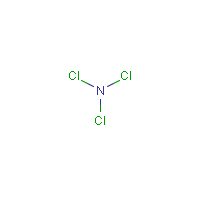Nitrogen chloride
Agent Name
Nitrogen chloride
Alternative Name
Nitrogen trichloride
CAS Number
10025-85-1
Formula
Cl3-N
Major Category
Nitrogen Compounds

Synonyms
Agene; Chlorine nitride; Trichloramine; Trichlorine nitride; Nitrogen trichloride; [ChemIDplus]
Category
Other Nitrogen Compounds
Sources/Uses
A byproduct of water chlorination, it is volatile and strongly irritating; May make the lung more susceptible to allergens; It is formed when organic matter in sweat and urine react with chlorine in swimming pools; [Reference #2]
Comments
Occupational asthma in indoor pool workers (lifeguards and a swimming teacher) confirmed by specific bronchoprovocation testing; [Malo] Chloramines include chloramide (NH2Cl), dichloramide (NHCl2), and trichloramide (NCl3). Tricloramide, also called nitrogen chloride or nitrogen trichloride, was the predominant vapor found in the indoor pool environment with a high chlorine to nitrogen ratio. All three swimming pools the study had been treated with sodium hypochlorite. Measured levels of NCl3 ranged from 0.23-0.57 mg/m3 in one pool and 0.1-0.31 in another pool. The concentration used for the challenge tests was 0.5 mg/m3. All 3 workers had immediate asthmatic reactions to the challenge tests, and one had an additional late reaction. [See Reference #1]
Reference Link #1
Biomedical References
Exposure Assessment
Lethal Concentration
LC50 (rat) = 112 ppm/1H
Reference Link #2
Adverse Effects
Asthma
Yes
Diseases, Processes, and Activities Linked to This Agent
Diseases
Occupational diseases associated with exposure to this agent: